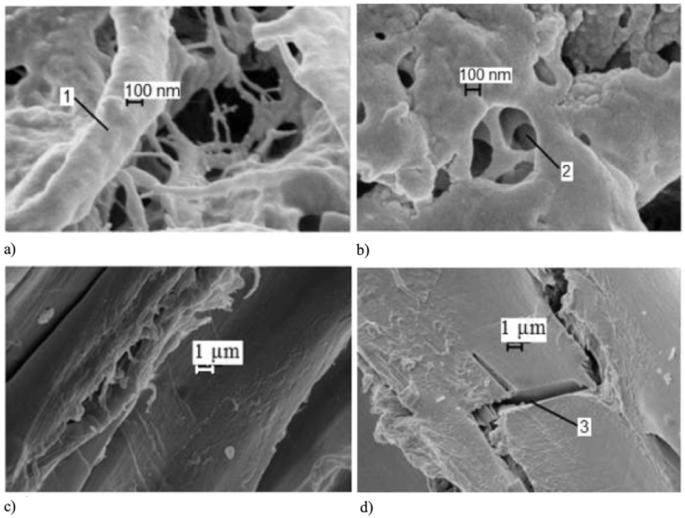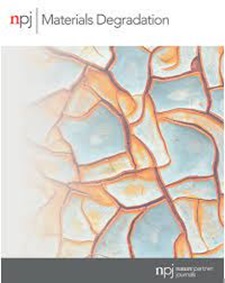等离子处理对天然纤维和合成纤维生物降解的影响
IF 6.6
2区 材料科学
Q1 MATERIALS SCIENCE, MULTIDISCIPLINARY
引用次数: 0
摘要
本研究调查了等离子体处理作为增强生物降解和改变纤维复合材料结构特征的一种手段的应用情况。研究方法包括研究对象的选择、复合材料的生产、低温等离子处理以及样品的生物降解性和机械强度处理。用纤维素强化纤维可显著提高机械强度。机械强度指标从 18 兆帕增加到 21 兆帕。用低温等离子体处理天然纤维可使机械强度从 18 兆帕增加到 25 兆帕。目前,用低温等离子体处理增强纤维可进一步提高机械强度,从 18 兆帕增加到 29 兆帕。电子显微镜显示,经等离子体处理和未经处理的样品的细胞壁微纤维存在一些差异,未经处理的纤维有碎屑和空隙。同时,经过等离子体处理的纤维在某些区域出现了类似木材炭化的结构变化。通过综合分析,这项研究强调了等离子处理对纤维素基复合材料降解动力学和形态特征的重大影响。研究结果表明,经过等离子处理的纤维的成分和行为发生了明显的变化,这表明纤维的生物降解能力正在增强。本研究中检测的天然纤维含有 28-30% 的木质素,而复合材料的木质素含量较低,仅为 21-23%。这些发现证实了这样的推论,即等离子处理会引起纤维结构的显著变化,从而加速 7 天的生物降解过程。本文章由计算机程序翻译,如有差异,请以英文原文为准。

Effects of plasma treatment on biodegradation of natural and synthetic fibers
This study investigates the application of plasma treatment as a means to enhance biodegradation and modify the structural characteristics of fibrous composites. The methodological component of the study includes the selection of the research object; production of composites; low-temperature plasma treatment, and treatment of biodegradability and mechanical strength of samples. The strengthening of fibers with cellulose leads to a significant improvement in mechanical strength. Such an indicator as mechanical strength increases from 18 to 21 MPa. Treatment of natural fibers with low-temperature plasma led to an increase in mechanical strength from 18 to 25 MPa. Treating reinforced fibers with low-temperature plasma currently results in an even greater enhancement in mechanical strength, increasing from 18 to 29 MPa.The electron microscopy of samples reveals some differences in cell wall microfibrils between plasma-treated and non-treated samples. The non-treated fibres are found to have chips and voids. Meantime, the plasma-treated fibres show structural changes in certain regions which resemble wood charring. Through a comprehensive analysis, this research underscores the substantial impact of plasma treatment on the degradation kinetics and morphological features of cellulose-based composites. The results reveal distinct alterations in the composition and behavior of plasma-treated fibres, signifying a shift towards enhanced biodegradability. The natural fibres examined in this study contained 28–30% lignin, whereas the composites exhibited a lower lignin content of 21–23%. These findings corroborate the inference that plasma treatment induces significant changes in fibre structure, accelerating the biodegradation process by 7 days.
求助全文
通过发布文献求助,成功后即可免费获取论文全文。
去求助
来源期刊

npj Materials Degradation
MATERIALS SCIENCE, MULTIDISCIPLINARY-
CiteScore
7.80
自引率
7.80%
发文量
86
审稿时长
6 weeks
期刊介绍:
npj Materials Degradation considers basic and applied research that explores all aspects of the degradation of metallic and non-metallic materials. The journal broadly defines ‘materials degradation’ as a reduction in the ability of a material to perform its task in-service as a result of environmental exposure.
The journal covers a broad range of topics including but not limited to:
-Degradation of metals, glasses, minerals, polymers, ceramics, cements and composites in natural and engineered environments, as a result of various stimuli
-Computational and experimental studies of degradation mechanisms and kinetics
-Characterization of degradation by traditional and emerging techniques
-New approaches and technologies for enhancing resistance to degradation
-Inspection and monitoring techniques for materials in-service, such as sensing technologies
 求助内容:
求助内容: 应助结果提醒方式:
应助结果提醒方式:


